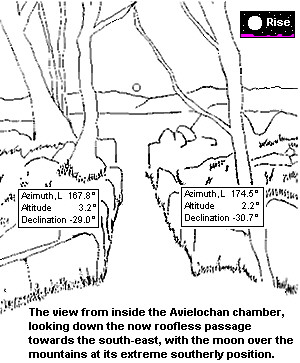
Avielochan, Strath Spey
Stones
of Wonder
QUICK LINKS ...
HOME PAGE
INTRODUCTION
WATCHING
THE SUN, MOON AND STARS
THE
MONUMENTS
THE
PEOPLE AND THE SKY
BACKGROUND
ARCHAEOASTRONOMY
USING
THE SITE DESCRIPTION PAGES
VISITING
THE SITES
THE
LEY LINE MYSTERY
THE
SITES
ARGYLL
AND ARRAN
MID
AND SOUTH SCOTLAND
NORTH
AND NORTH-EAST SCOTLAND
WESTERN
ISLES AND MULL
Data
DATES
OF EQUINOXES AND SOLSTICES, 1997 to 2030 AD
DATES
OF MIDSUMMER AND MIDWINTER FULL MOONS, 1997 to 2030 AD
POSTSCRIPT
Individual
Site References
Bibliography
Links
to other relevant pages
Contact
me at : rpollock456@gmail.com
Chambered Cairn NH908167*
How to find : The site is 3km north-east of Aviemore. Heading north on the A95 a track at Avielochan leads east towards the main railway line. Just before the railway bridge across the railway the site can be seen on a small natural wooded knoll on the left. Park in the space before the bridge. The field is often under crop, so follow the very edge of the field (by the railway) across to the knoll.
Best time of year to visit : Major standstill moonset. (see dates).
 This chambered cairn is set within a little stand of trees at the edge
of a field and is almost hidden away, especially in summer. It is definitely
of the Clava type, but lacks a surrounding ring of freestanding stones.
The cairn has been robbed in the past of much of its height. Most of the
outer kerb still remains though, defining a cairn about 13m in diameter.
Like the sites at Clava itself there is a platform of stones outside the
kerb, here about three metres wide.
This chambered cairn is set within a little stand of trees at the edge
of a field and is almost hidden away, especially in summer. It is definitely
of the Clava type, but lacks a surrounding ring of freestanding stones.
The cairn has been robbed in the past of much of its height. Most of the
outer kerb still remains though, defining a cairn about 13m in diameter.
Like the sites at Clava itself there is a platform of stones outside the
kerb, here about three metres wide.
The largest kerbstone is still in place at the west side of the entrance, but its partner at the opposite side has been removed. The chamber and passage are distinct, having been cleared out during an excavation of the site before the First World War. The passage walls are nowhere more than about a metre high, while the chamber walls rise to only half a metre. The finds from the excavation consisted of some charcoal and a fragment of a jet armlet.
This site is visited by modern practitioners of witchcraft, who have scratched a pentagram into one of the stones of the passage. You may also find the remains of coloured candles set inside the chamber.
Avielochan is unusual in that the passage is orientated towards the south-east; nearly all the other Clava type cairn passages point towards the south-west. The azimuth range between 168° and 174°, combined with the horizon height of 2°-3°, means that the indicated declination is that of the extreme southern position of the moon during its major standstill. The range of declinations is from -29.0° to -30.7°. During the standstill the southern moon would rise over the spectacular Cairngorm range, and set again very shortly afterwards.